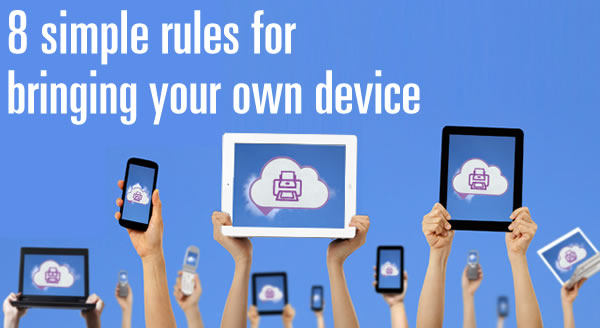
Cisco have come up with a term called “Comprehensive BYOD” as well as the eight things it comprises, and the idea’s so good that we’re going to borrow it. We’ve taken their eight points — they called them “foundational capabilities” — improved on them with a little re-ordering, re-wording and a jauntier name because we think that doing so makes them more effective. Here are our 8 Simple Rules for Bringing Your Own Device, or what organizations implementing BYOD need to do:
- Automatically enforce mobile device policies for usage and corporate resource access
- Monitor and remotely “wipe” corporate data from managed devices
- Give users secure access to the corporate network through wired, wifi, remote and mobile means
- Give users the ability to simultaneously log in on multiple devices, because it’s now a multi-screen world
- Give users the ability to move between networks seamlessly and securely, because we’re all “on the go” now
- Provide simple, user-friendly user authentication for various mobile device makes and models
- Provide corporate collaboration tools that work on all end-user devices
- Support separate “work” and “personal” personas to keep corporate data separate
Through the strategic and judicious use of mobile device management (MDM), container applications, back office integration, and good practices and policies, you can follow the 8 Simple Rules, give your company’s employees the ability to use the devices they know and love, and get the most out of your BYOD program.
According to Cisco’s survey of 2,415 mobile users in 6 countries (Brazil, China, Germany, India, United Kingdom, and United States), as much as $3,150 per employee can be saved through “Comprehensive BYOD”. Cisco says that under a Comprehensive BYOD plan, employees will spend an average of $965 on their devices, plus another $734 in annual data plans, or a total of $1699 that they no longer have to spend since they’ve offloaded that cost onto their employees.
We beg to differ with Cisco. While there are some cost savings that can come from BYOD, we feel that employers should help employees cover the costs of work-related use of their devices through stipends or some other compensation plan. In our opinion, the really big wins that come from BYOD are employee productivity (up to 81 minutes of time saved every week, for every employee, according to Cisco’s survey) and satisfaction.

4 replies on “8 Simple Rules for Bringing Your Own Device (or: Comprehensive BYOD and its Benefits)”
[…] This article also appears in Global Nerdy. […]
Interesting list Joey, but all items listed are pretty much included in EAS. What will take an organization to the next level with MDM or better yet MAM?
Anthony Bartolo: Yes, but as our experience with clients has shown, a lot of this stuff is still new to a great many people. Hence the list.
[…] 8 Simple Rules for Bringing Your Own Device (or: Comprehensive BYOD and its Benefits) Guter Ansatz, sollte aber eigentlich nicht dazu dienen, Kosten zu sparen, sondern jedem Mitarbeiter das zu geben, womit er am effektivsten und effizientesten arbeitet. […]